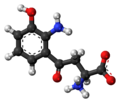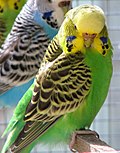is determined by the ommochromes. Ommochromes are also found in the chromatophores of cephalopods, and in spiders. Ommochromes are metabolites of tryptophan...
2 KB (248 words) - 20:32, 8 July 2024
change from yellow to white takes longer. The yellow coloring is due to ommochrome pigments being produced. The appearance of white is due to guanine and...
11 KB (1,259 words) - 09:20, 22 August 2024
Juchault, E; Katakura, Y. (1997). "Genetic and Biochemical Studies on Ommochrome Genesis in an Albino Strain of a Terrestrial Isopod, Armadillidium vulgare"...
35 KB (3,549 words) - 23:10, 20 August 2024
and leg spans up to 250 mm (9.8 in). Only three classes of pigment (ommochromes, bilins and guanine) have been identified in spiders, although other...
121 KB (13,435 words) - 15:46, 13 September 2024
Physiology Meets Pathology". Nature Reviews Neuroscience. 13 (7): 465–477. doi:10.1038/nrn3257. PMC 3681811. PMID 22678511. Kynurenine Ommochrome v t e...
3 KB (112 words) - 02:17, 9 September 2024
the sepia mutant is sepia, a reddish-brown color. In wild-type flies, ommochromes (brown) and drosopterins (red) give the eyes the typical red color. The...
145 KB (16,685 words) - 07:45, 6 September 2024
"The functional morphology of color changing in a spider: development of ommochrome pigment granules". Journal of Experimental Biology. 211 (5): 780–789....
45 KB (5,939 words) - 21:08, 18 May 2024
Chrysanthemum segetum. Yellow coloration is likely due to the presence of ommochrome compounds and/or their precursors, such as xanthommatin and 3-hydroxykynurenine...
27 KB (3,235 words) - 20:18, 4 April 2024
chemically tested and found to be fossilized melanin, as opposed to ommochromes or pterins (which are ocular pigments used by many invertebrate groups)...
31 KB (3,226 words) - 23:05, 21 June 2024
"Coloration principles of nymphaline butterflies - thin films, melanin, ommochromes and wing scale stacking". The Journal of Experimental Biology. 217 (Pt...
32 KB (3,908 words) - 20:24, 18 April 2024
2-Aminomuconic semialdehyde is a metabolite of tryptophan. Muconic acid Ommochrome He, Z.; Spain, J. (1999-08-01). "Preparation of 2-aminomuconate from 2-aminophenol...
3 KB (109 words) - 22:01, 22 February 2024
"Coloration principles of nymphaline butterflies - thin films, melanin, ommochromes and wing scale stacking". Journal of Experimental Biology. 217 (12):...
49 KB (5,810 words) - 22:06, 25 July 2024
fornicata are the result of biochemical pigments. These bands contain ommochrome pigments that absorb at roughly five-hundred nanometers to selectively...
24 KB (2,579 words) - 22:29, 2 January 2024
have not been well-studied, but one common theory is that they may be ommochrome pigments, although no discoveries have been made to prove this. Pseudoceros...
20 KB (1,721 words) - 14:04, 23 April 2024













